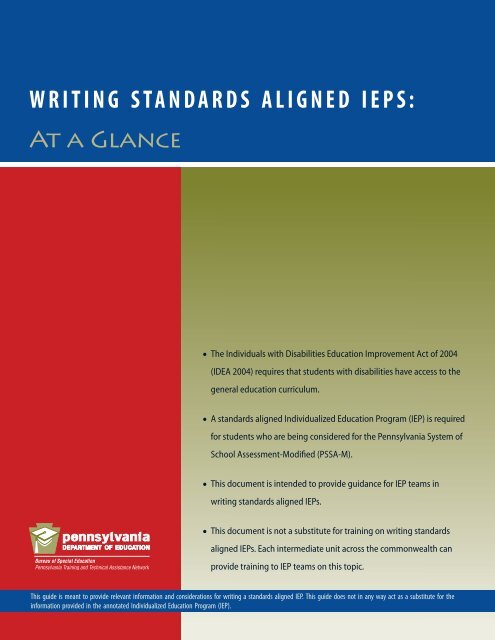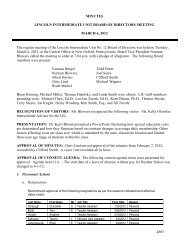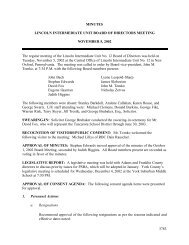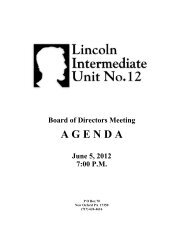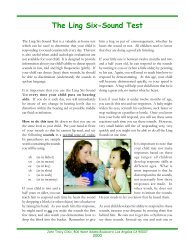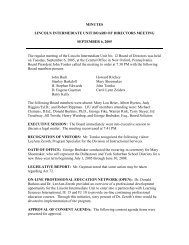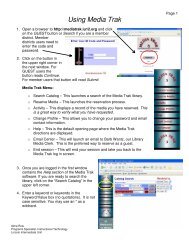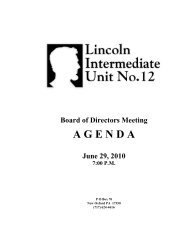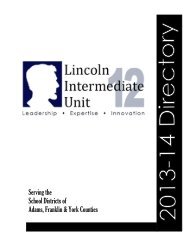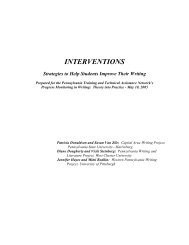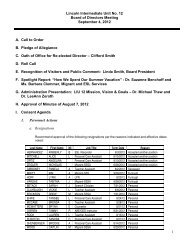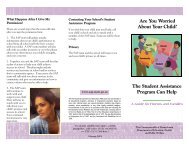WRITING STANDARDS ALIGNED IEPS: - Lincoln Intermediate Unit 12
WRITING STANDARDS ALIGNED IEPS: - Lincoln Intermediate Unit 12
WRITING STANDARDS ALIGNED IEPS: - Lincoln Intermediate Unit 12
You also want an ePaper? Increase the reach of your titles
YUMPU automatically turns print PDFs into web optimized ePapers that Google loves.
Writing Standards Aligned IEPs:<br />
At a Glance<br />
• The Individuals with Disabilities Education Improvement Act of 2004<br />
(IDEA 2004) requires that students with disabilities have access to the<br />
general education curriculum.<br />
• A standards aligned Individualized Education Program (IEP) is required<br />
for students who are being considered for the Pennsylvania System of<br />
School Assessment-Modified (PSSA-M).<br />
• This document is intended to provide guidance for IEP teams in<br />
writing standards aligned IEPs.<br />
• This document is not a substitute for training on writing standards<br />
aligned IEPs. Each intermediate unit across the commonwealth can<br />
provide training to IEP teams on this topic.<br />
This guide is meant to provide relevant information and considerations for writing a standards aligned IEP. This guide does not in any way act as a substitute for the<br />
information provided in the annotated Individualized Education Program (IEP).
2<br />
Present Levels of Academic Achievement and<br />
Functional Performance<br />
This section of the IEP must include the following<br />
information:<br />
• Present levels of academic achievement<br />
Most recent evaluation and assessment<br />
results (i.e., how is the student performing<br />
in relation to the general education<br />
curriculum: standards, anchors, big ideas,<br />
concepts and competencies)<br />
Progress toward current goals<br />
Assessments related to secondary<br />
transition, if applicable<br />
• Present levels of functional performance–<br />
include as appropriate:<br />
Functional Behavior Assessment (FBA) results<br />
Ecological assessment results<br />
Progress toward current goals<br />
• Present levels related to postsecondary<br />
transition goals, interests and preferences for<br />
postsecondary education/training, employment<br />
and independent living (if applicable)<br />
• Parental concerns for enhancing the education<br />
of the student<br />
• How the student’s disability affects involvement<br />
and progress in the general education curriculum<br />
• Strengths (including specially designed<br />
instruction that has been successful for the<br />
student)<br />
• Academic, developmental, and functional<br />
needs related to the student’s disability<br />
Key Concept: The IEP team should include assessment<br />
data related to the standards. This includes anchors<br />
and elements of the Standards Aligned System (SAS)<br />
Curriculum Framework in the student’s present levels.<br />
This will enable the IEP team to write standards<br />
aligned measurable annual goals (MAGs). Present<br />
levels should include relevant data in such a way that<br />
the data can be easily understood.<br />
The information should provide a holistic view of the<br />
child, including both instructional and grade-level<br />
information.<br />
The Present Levels section should include at least<br />
three of the four different types of assessment<br />
(sometimes diagnostic data may not be available):<br />
• Formative<br />
• Summative<br />
• Benchmark<br />
• Diagnostic<br />
The information in the Present Levels section<br />
of the IEP provides a baseline for developing the<br />
IEP and writing MAGs.<br />
Prioritizing Student Needs<br />
Key Concept: The next step is to prioritize student<br />
needs based on the information from the Present<br />
Levels of Academic Achievement and Functional<br />
Performance (including secondary transition<br />
needs). This prioritization will help determine the<br />
most appropriate MAGs when considering student<br />
strengths, needs, and how the student’s disability<br />
affects his/her involvement in the general curriculum.<br />
Reference information to assist the IEP team to<br />
prioritize needs:<br />
• PSSA Blueprint<br />
• Grade-level standards<br />
• Grade-level assessment anchors<br />
• Grade-level SAS Curriculum Framework<br />
components<br />
Big Ideas<br />
Concepts<br />
Competencies<br />
Essential Questions<br />
Vocabulary
Participation in State and Local Assessments<br />
Key Concept: In Pennsylvania there are five options for<br />
test participation for students with disabilities:<br />
• The PSSA<br />
• The PSSA with accommodations<br />
• The PSSA-Modified (Spring 2010 - Math only;<br />
Grades 4-8 and 11)<br />
• The PSSA-Modified with accommodations<br />
(Spring 2010 - Math only; Grades 4-8 and 11)<br />
• The PASA (Pennsylvania Alternate System of<br />
Assessment)<br />
Indicate the options determined by the IEP team.<br />
Measurable Annual Goals (MAGs)<br />
Participation in the PSSA-M requires a student’s IEP to<br />
be standards aligned. This includes MAGs aligned to<br />
grade-level standards.<br />
The components of a MAG include:<br />
• Condition<br />
• Name<br />
• Behavior<br />
• Performance criteria<br />
As an extension of prioritizing student needs, the<br />
IEP team includes wording from any of the following<br />
sources to meet the requirements of writing a<br />
standards aligned MAG:<br />
• Grade-level standards<br />
• Grade-level assessment anchors<br />
• Grade-level eligible content<br />
• Grade-level big ideas<br />
• Grade-level concepts<br />
• Grade-level competencies<br />
Not every MAG must be standards aligned. For<br />
example, functional goals related to independent<br />
living, behavior, or personal hygiene do not align with<br />
the academic standards.<br />
Key Concept: A MAG is written using a grade-level<br />
standard (or some component of the SAS curriculum<br />
framework). However, a student may be working<br />
on the grade-level goal using instructional-level<br />
materials.<br />
Example: Reading standard 1.2 is Reading, Analyzing<br />
and Interpreting Text.<br />
Standard 1.2.6.A states: Evaluate text organization<br />
and content to determine the author’s purpose, point<br />
of view, and effectiveness.<br />
Below are some options of how the above standard<br />
may be written into a MAG with relevant specially<br />
designed instruction (SDI):<br />
• Determine the author’s purpose, point of view,<br />
and effectiveness (a grade-level standard),<br />
but begin working on this standard using<br />
instructional-level reading material then adjust<br />
as the student’s reading level improves.<br />
• Determine the author’s purpose, point of view,<br />
and effectiveness (a grade-level standard)<br />
using grade-level reading material with the use<br />
of effective adaptations, accommodations and<br />
SDI. For example, graphic organizers, enlarged<br />
print, chunking the amount of reading<br />
required at one sitting.<br />
• Determine the author’s purpose, point of view,<br />
and effectiveness (a grade-level standard)<br />
using modified grade-level reading material<br />
(e.g., simplified vocabulary).<br />
In addition, a student may have a MAG in which he/<br />
she is working toward part of a grade-level standard.<br />
Examples include:<br />
• Determine the author’s point of view (begin<br />
by working toward this part of a standard using<br />
instructional-level reading materials then adjust<br />
as the student’s reading level improves).<br />
• Determine the author’s point of view using<br />
grade-level reading material with the use<br />
3
of effective adaptations, accommodations<br />
and SDI.<br />
• Determine the author’s point of view using<br />
modified grade-level reading material.<br />
The examples above used a reading standard. The IEP<br />
team may also use a big idea, concept, or competency<br />
as the stem of the goal.<br />
Examples that apply to mathematics:<br />
Standard 2.1.5.D states: Apply place value concepts<br />
to order and compare decimals and to express whole<br />
numbers and decimals in expanded notation.<br />
• One option: A student’s MAG is to achieve<br />
the grade-level standard but the student<br />
requires effective adaptations, accommodations<br />
and SDI (e.g., graphic organizers, initial<br />
instruction using concrete materials, use<br />
of Concrete-Representational-Abstract<br />
(CRA) method of instruction, use of guided<br />
notes and scaffolding).<br />
• Another option: A student’s MAG is to<br />
achieve part of the grade-level standard<br />
(with or without the use of adaptations,<br />
accommodations or SDI as appropriate).<br />
For example: The student will work to order<br />
and compare decimals. Another example of a<br />
MAG coming from part of a standard includes<br />
a MAG where a student will work to express<br />
whole numbers and decimals in expanded<br />
notation.<br />
Examples of writing a standards aligned MAG using<br />
the SAS curriculum framework:<br />
A competency for 4th grade mathematics is:<br />
Apply increasingly sophisticated strategies to<br />
solve multiplication and division problems that<br />
include, and go beyond, basic facts and one-digit<br />
multiplier problems, using properties of addition<br />
and multiplication. Select and apply appropriate<br />
strategies to estimate and/or solve a variety of<br />
problems including problems involving addition<br />
and subtraction of decimals and of fractions with<br />
like denominators.<br />
Based on the above competency and a student’s<br />
prioritized need based on an appropriate sampling<br />
of assessments in the Present Levels of Academic<br />
Achievement and Functional Performance section<br />
of the IEP, an appropriate MAG might include the<br />
following stem:<br />
Solving multiplication and division problems that<br />
include and go beyond basic facts and one-digit<br />
multiplier problems<br />
An appropriate SDI may include the use of concrete<br />
materials during initial instruction, use of CRA<br />
method of instruction, structured worksheets to aid<br />
in algorithm completion, instruction on the use of an<br />
alternative algorithm that is efficient for the student.<br />
Specially Designed Instruction (SDI)<br />
Key Concept: Specially designed instruction is what<br />
the student needs to access the grade level general<br />
education curriculum successfully.<br />
SDI is determined on a case-by-case basis to meet the<br />
individual needs of the student in relation to access<br />
to the general education curriculum and meeting his/<br />
her MAG. For example, you may be writing an IEP for<br />
a student with a standards aligned grade level MAG<br />
even though the student is at a lower instructional<br />
reading level. The SDI provides the student with what<br />
he/she needs to access the curriculum and work<br />
toward the grade-level goal.<br />
When selecting individually appropriate SDI, keep in<br />
mind:<br />
• SDI should be delivered in many settings by<br />
some, or all educators<br />
• SDI should be specific to skill deficits identified<br />
from the assessment process<br />
• SDI must come from effective instructional and<br />
learning practices<br />
4
Monitoring of Progress (this information relates<br />
to the MAG)<br />
Key Concept: The student’s MAG is standards aligned.<br />
Therefore the purpose for the monitoring of progress<br />
is to measure the student’s progress toward meeting<br />
the standard. One type of assessment is not necessarily<br />
sufficient for measuring attainment of the entire<br />
goal.<br />
In the IEP, required components of progress monitoring<br />
describe how the student’s progress toward meeting<br />
the goal will be measured. Consider all four types of<br />
assessment for the purpose of monitoring progress:<br />
• Summative (e.g., PSSA, Achievement tests)<br />
• Formative (e.g., checklists, rubrics, weekly<br />
probes, work samples)<br />
• Benchmark (e.g., 4Sight, DIBELS, AIMsweb,<br />
Riverside)<br />
• Diagnostic (e.g., Key Math 3, GRADE, GMADE)<br />
Here is an example of monitoring progress:<br />
Every 9 weeks parents will receive a report of progress<br />
toward meeting the reading goal as measured by:<br />
• Weekly probes to measure ongoing progress<br />
(oral reading fluency)<br />
• Accuracy graphed on related classroom<br />
comprehension checks, quizzes, and tests<br />
• 4Sight Reading Benchmark from November,<br />
January, and April<br />
• PSSA Reading (administered in April – Parent<br />
report to be received in August)<br />
Steps to Creating a Standards Aligned IEP<br />
Adapted from Standards-Based Individual Education Program Examples<br />
from Project Forum at NASDSE<br />
1. Consider the grade-level content standards<br />
for the grade in which the student is<br />
enrolled.<br />
a. What is the intent of the content standard,<br />
eligible content, big idea, concept or<br />
competency?<br />
b. What is the content standard<br />
saying that the student must know<br />
and be able to do? The SAS Curriculum<br />
Framework can assist in determining<br />
the intent and requirements of content<br />
standards.<br />
2. Examine classroom and student data to<br />
determine where the student is functioning in<br />
relation to the grade-level standards.<br />
a. Has the student been taught content<br />
aligned with grade-level standards?<br />
b. Has the student been provided<br />
appropriate instructional scaffolding<br />
to attain grade-level expectations?<br />
c. Were the lessons and teaching materials<br />
used to teach the student aligned with<br />
the grade-level standards?<br />
d. Was the instruction evidence-based?<br />
3. Develop the present level of academic<br />
achievement and functional performance.<br />
Describe the individual strengths and needs<br />
of the student in relation to accessing and<br />
mastering the general curriculum.<br />
a. What do we know about the student’s<br />
response to academic instruction<br />
(gather information from at least 3 of<br />
the 4 types of assessment)?<br />
b. What programs, accommodations,<br />
and/or interventions have been<br />
successful with the student?<br />
c. What have we learned from previous IEPs<br />
and student data that can inform decision<br />
making?<br />
d. Are there assessment data (state, district,<br />
and/or classroom) that can provide useful<br />
information for making decisions about the<br />
student’s strengths and needs?<br />
5
Consider the factors related to the student’s<br />
disability and how they affect how the student<br />
learns and demonstrates what he/she knows.<br />
e. How does the student’s disability affect<br />
participation and progress in the general<br />
curriculum?<br />
f. What supports does the student need to<br />
learn the knowledge and attain the skills<br />
to progress in the general curriculum?<br />
g. Is the student on track to achieve gradelevel<br />
proficiency within the year?<br />
4. Develop MAGs aligned with grade-level<br />
academic content standards.<br />
a. What are the student’s prioritized needs<br />
as identified in the present level of<br />
performance?<br />
b. What can the student reasonably be<br />
expected to accomplish in one school year?<br />
c. Are the conditions for meeting the goal<br />
addressed?<br />
d. How will the outcome of the goal be<br />
measured?<br />
5. Assess and report the student’s progress<br />
throughout the year.<br />
a. How does the student demonstrate what<br />
he/she knows on classroom, district and<br />
state assessments?<br />
b. Are a variety of assessments used to<br />
measure progress?<br />
c. How will progress be reported to parents?<br />
6. Identify specially designed instruction including<br />
accommodations and/or modifications needed<br />
to access and progress in the general education<br />
curriculum.<br />
a. What accommodations are needed<br />
to enable the student to access the<br />
knowledge in the general education<br />
curriculum?<br />
b. What accommodations have been<br />
used with the student and were they<br />
effective?<br />
c. Has the complexity of the material<br />
been changed in such a way that the<br />
content has been modified?<br />
7. Determine the most appropriate assessment<br />
option.<br />
a. What types of assessment are options?<br />
b. What types of responses do the<br />
assessment options require?<br />
c. For which assessment(s) is the student<br />
eligible?<br />
d. What accommodations are allowed<br />
on the assessment(s)?<br />
e. Are the accommodations approved<br />
for the assessment(s) also used in the<br />
classroom?<br />
f. Has the student received standards<br />
aligned, grade-level instruction?<br />
g. Was the instruction evidence-based?<br />
h. What is the student’s instructional<br />
level?<br />
i. How different is the student’s<br />
instructional level from the level of<br />
typical peers?<br />
j. What can be learned from the<br />
student’s previous state assessment<br />
results?<br />
6
COMMONWEALTH OF PENNSYLVANIA<br />
Edward G. Rendell<br />
Governor<br />
DEPARTMENT OF EDUCATION<br />
Gerald L. Zahorchak<br />
Secretary<br />
Diane Castelbuono<br />
Deputy Secretary<br />
Office for Elementary and Secondary Education<br />
John J. Tommasini<br />
Director<br />
Bureau of Special Education<br />
Patricia Hozella<br />
Assistant Director<br />
Bureau of Special Education<br />
9/09


